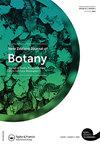天竺葵科植物的归化及其对新西兰生物安全监测的意义
IF 1.4
4区 生物学
Q4 PLANT SCIENCES
引用次数: 0
摘要
摘要:在新西兰奥特罗阿,记录了新归化的克氏松。虽然爱之树是它的口语化的名字,它是一种小的,多肉的草本植物在天门冬科,是加那利群岛的土著。它已经在新西兰种植了至少几十年。该物种最近在惠灵顿周围的多个地点被采集到,Napier和Ōtaki福克斯附近也有采集,另外还有一份来自基督城的野生植物的报告。尽管它的体积很小,但a.l axum可以密集生长,增加杂草,使表面窒息,并取代栖息地的本地物种,如开放的岩石河岸。在惠灵顿,A. laxum于2019年首次被发现在野生生长,但现在已经发现它在整个城市的多个地点都有分布。它要么是通过其微小的、随风传播的种子大举传播,要么是在惠灵顿的植物群中是一种独特的物种,但它已经潜伏了一段时间而未被发现。这两种情况都令人担忧,而且A. laxum提供了另一个例子,表明该国目前的监测存在缺陷——议会环境专员最近将其描述为很大程度上是被动和偶然的——对新西兰种植的数万种外来植物中新归化的杂草。我们感谢Ines Schönberger (CHR, Manaaki Whenua Landcare Research)和Ewen Cameron (AK, Auckland Museum)检查各自机构的藏品;iNaturalist的用户,特别是Tim Park, Joe Dillon和Chris Close,以及Rebecca Turner,为她的iNaturalist观察艾克森laxum提供更多信息;Barry Sneddon对草稿的评论;感谢审稿人的建设性意见。披露声明作者未报告潜在的利益冲突。本文章由计算机程序翻译,如有差异,请以英文原文为准。
Naturalisation of the tree of love Aichryson laxum (Crassulaceae) and its implications for biosecurity surveillance in New Zealand
ABSTRACTAichryson laxum is documented as newly naturalised in Aotearoa New Zealand. Although tree of love is its colloquial name, it is a small, succulent herb in the Crassulaceae, and is indigenous to the Canary Islands. It has been cultivated in New Zealand for at least several decades. The species has recently been collected wild at multiple sites around Wellington, with collections also from Napier and near Ōtaki Forks, and an additional report of wild plants from Christchurch. Despite its small size, A. laxum can grow densely, adding to the weeds smothering surfaces and displacing indigenous species from habitats such as open, rocky banks. Within Wellington, A. laxum was first noticed to be growing wild in 2019, but it has now been found to be established at multiple sites throughout the city. Either it is spreading aggressively via its tiny, wind-dispersed seeds, or it has lain undetected for some time, even though it is a distinctive species among Wellington’s flora. Both scenarios are concerning, and A. laxum provides another example of the shortcomings of the nation’s current surveillance – recently described by the Parliamentary Commissioner for the Environment as largely passive and serendipitous – for emerging weeds newly naturalising from the tens of thousands of exotic plant species cultivated in New Zealand.KEYWORDS: BiosecurityCanary IslandsMacaronesiasucculentssurveillanceweedsWellington AcknowledgementsWe thank Ines Schönberger (CHR, Manaaki Whenua Landcare Research) and Ewen Cameron (AK, Auckland Museum) for checking the collections of their respective institutions; the users of iNaturalist, particularly Tim Park, Joe Dillon, and Chris Close, as well as Rebecca Turner for additional information about her iNaturalist observation of Aichryson laxum; Barry Sneddon for comments on a draft manuscript; and the reviewers for their constructive comments.Disclosure statementNo potential conflict of interest was reported by the author(s).
求助全文
通过发布文献求助,成功后即可免费获取论文全文。
去求助
来源期刊

New Zealand Journal of Botany
生物-植物科学
CiteScore
2.20
自引率
22.20%
发文量
27
审稿时长
>12 weeks
期刊介绍:
The New Zealand Journal of Botany publishes original research papers, review papers, perspectives, short communications, forum articles, letter and book reviews. We welcome submissions relevant to all aspects of the botany, mycology, and phycology of the South Pacific, Australia, South America, and Southern Africa. The journal’s subject matter encompasses biosystematics and biogeography, ecology, physiology, biochemistry, genetics, reproductive biology, structure and development, taxonomy, ethnobotany, palaeobotany, bryology, lichenology, mycology, plant pathology, and phycology.
 求助内容:
求助内容: 应助结果提醒方式:
应助结果提醒方式:


